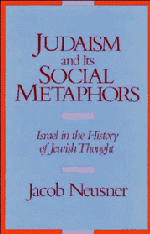Book contents
- Frontmatter
- Contents
- Preface
- List of Abbreviations
- Introduction
- 1 Imagining Society, Re-visioning “Israel”
- PART I “Israel” in the First Statement of Judaism, 70–300 C.E.
- PART II “Israel” in the Second Statement of Judaism, 300–600 C.E.
- 6 “Israel” on Its Own Terms
- 7 “Israel” as Family
- 8 “Israel” as Family and Also Singular Nation
- 9 “Israel” as Sui Generis
- 10 The Second Phase of the Judaism of the Dual Torah and Its Social Metaphors
- PART III Same Metaphors, Other Systems
- General Index
- Index to Biblical and Talmudic References
- Frontmatter
- Contents
- Preface
- List of Abbreviations
- Introduction
- 1 Imagining Society, Re-visioning “Israel”
- PART I “Israel” in the First Statement of Judaism, 70–300 C.E.
- PART II “Israel” in the Second Statement of Judaism, 300–600 C.E.
- 6 “Israel” on Its Own Terms
- 7 “Israel” as Family
- 8 “Israel” as Family and Also Singular Nation
- 9 “Israel” as Sui Generis
- 10 The Second Phase of the Judaism of the Dual Torah and Its Social Metaphors
- PART III Same Metaphors, Other Systems
- General Index
- Index to Biblical and Talmudic References
Summary
The Metaphor of the Family, “Israel”
When sages wished to know what (an) “Israel” was, in the fourth century they reread the story of the origins of Scripture's “Israel” for the answer. To begin with, as Scripture told them the story, “Israel” was a man, Jacob, and his children are “the children of Jacob.” That man's name was also “Israel,” and, it followed, “the children of Israel” composed the extended family of that man. By extension, “Israel” formed the family of Abraham and Sarah, Isaac and Rebecca, Jacob and Leah and Rachel. “Israel” therefore invoked the metaphor of genealogy to explain the bonds that linked persons unseen into a single social entity; the shared traits were imputed, not empirical. That social metaphor of “Israel” – a simple one, really, and easily grasped – bore consequences in two ways. First, children in general are admonished to follow the good example of their parents. The deeds of the patriarchs and matriarchs therefore taught lessons on how the children were to act. Of greater interest in an account of “Israel” as a social metaphor, “Israel” lived twice, once in the patriarchs and matriarchs, a second time in the life of the heirs as the descendants relived those earlier lives. The stories of the family were carefully reread to provide a picture of the meaning of the latterday events of the descendants of that same family.
- Type
- Chapter
- Information
- Judaism and its Social MetaphorsIsrael in the History of Jewish Thought, pp. 112 - 144Publisher: Cambridge University PressPrint publication year: 1989



